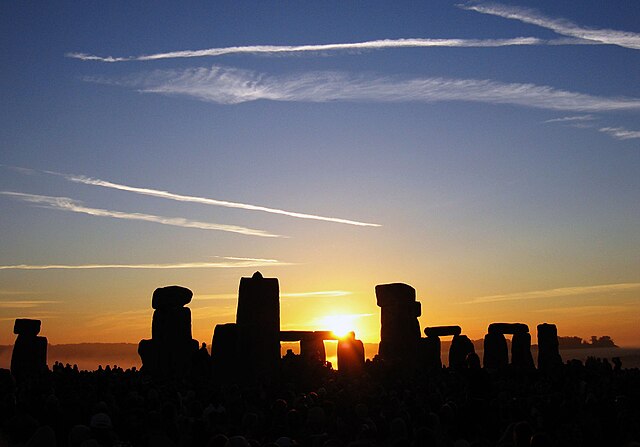Top Qs
Timeline
Chat
Perspective
Summer Solstice at Stonehenge
Annual event From Wikipedia, the free encyclopedia
Remove ads
Summer Solstice at Stonehenge is an annual event which takes place on the evening of the 20 June and the morning of 21 June. The monument is aligned towards the sunrise on the summer solstice and sunset on the winter solstice. Stonehenge is a place of worship to Neo-Druids, Pagans and other "Earth based' or 'old' religions.[1]

History Apart from a few interested visitors, the first recorded summer solstice gatherings started to occur after the opening of the railway to Salisbury in 1859 as a connecting point. According to Andy Worthington in his book Stonehenge Celebration and Subversion[2] the solstice initially became of note to antiquarians and aristocratic patrons, followed by locals on foot, bicycles, horse drawn carriages. A party atmosphere was often present. By the turn of the twentieth century Druid revivalists started to hold ceremonies with groups of onlookers and the site was fenced for the first time.[3] The arrival of motorised vehicles also facilitated larger attendances, particularly when a solstice coincided with a weekend. Later influences included the British folk revival, right to roam, Beaulieu Jazz Festivals of the 1950s, combined with the greater social freedoms of the post war period.[2] By the early 1970s the site become a focus for counterculture and a free festival emerged. This ended in the so-called Battle of the Beanfield in 1985. Access was then restricted for the next few years until the High Court ruled the exclusion zone unlawful and the modern Open Access was created at the turn of the millennium.[4]
Open Access is one of the few times a year the general public can enter the main circle for free. The other times are the winter solstice and spring and autumnal equinoxes. The main focus of the gathering is based around the sunset, the night time vigil and observing the sunrise. Various ceremonies and rituals also take place, as well as the playing of acoustic music, dancing and singing. People are also able to touch the stones. Please see below list of past gatherings.

Remove ads
See also
- Avebury – Neolithic henge monument in Wiltshire, England
- Cultural depictions of Stonehenge
- Manhattanhenge – Solar phenomenon in Manhattan, New York City
References
Wikiwand - on
Seamless Wikipedia browsing. On steroids.
Remove ads
